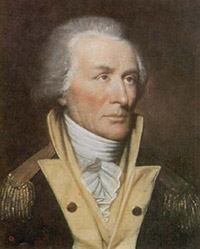Carolina Gamecock
| Thomas Sumter | |
|---|---|

Portrait by Rembrandt Peale (c. 1795)
|
|
|
United States Senator from South Carolina |
|
|
In office December 15, 1801 – December 16, 1810 |
|
| Preceded by | Charles Pinckney |
| Succeeded by | John Taylor |
| Member of the U.S. House of Representatives from South Carolina's 4th district |
|
|
In office March 4, 1797 – December 15, 1801 |
|
| Preceded by | Richard Winn |
| Succeeded by | Richard Winn |
|
In office March 4, 1789 – March 3, 1793 |
|
| Preceded by | Position established |
| Succeeded by | Richard Winn |
| Personal details | |
| Born |
August 14, 1734 Hanover County Province of Virginia |
| Died | June 1, 1832 (aged 97) near Stateburg, South Carolina |
| Resting place | Thomas Sumter Memorial Park, Sumter County, South Carolina |
| Military service | |
| Allegiance |
|
| Service/branch | Virginia provincial militia South Carolina state militia |
| Years of service |
|
| Rank |
|
| Commands |
|
| Battles/wars |
American Revolutionary War |
Thomas Sumter (August 14, 1734 – June 1, 1832) was a soldier in the Colony of Virginia militia; a brigadier general in the South Carolina militia during the American War of Independence, a planter, and a politician. After the United States gained independence, he was elected to the United States House of Representatives and to the United States Senate, where he served from 1801 to 1810, when he retired. Sumter was nicknamed the "Carolina Gamecock," for his fierce fighting style against British soldiers after they burned down his house during the Revolution.
Thomas Sumter was born in Hanover County, Province of Virginia. Little is known of his parentage. Given just a rudimentary education on the frontier, the young Sumter enlisted in the Virginia militia.
At the end of the Anglo-Cherokee War, in 1761, Sumter was invited to join what was to become known as the "Timberlake Expedition," organized by Colonel Adam Stephen and led by Henry Timberlake (who had volunteered for the assignment). The purpose of the expedition was to visit the Overhill Cherokee towns and renew friendship with the Cherokee People following the war. The small expeditionary party consisted of Timberlake, Sumter (who was partially financing the venture with borrowed money), an interpreter named John McCormack, and a servant.
At one point early in the nearly year and a half long journey, an entry in Timberlake's journal describes Sumter's swimming nearly a half-mile in the icy waters to retrieve their canoe, which had drifted away while they were exploring a cave. The party arrived in the Overhill town of Tomotley on December 20, where they were greeted by the town's head man, Ostenaco (or "Mankiller") and soon found themselves participants in a peace pipe ceremony.
...
Wikipedia
